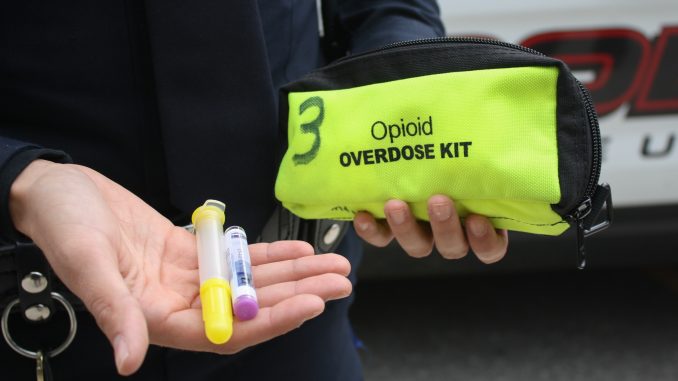
To assist with opioid overdoses on or around Main Campus, all Temple Police officers began carrying naloxone last month.
Naloxone, sold under the brand name Narcan, is a medication that blocks the effects of opioids and is used in emergencies to save people who have overdosed. The drug can be administered through a patient’s nose, vein or bone. Temple Police administers naloxone through a nasal spray, said Denise Wilhelm, deputy chief of operations for Campus Safety Services.
Temple Police used naloxone for the first time last Wednesday, when officers successfully revived a 23-year-old man who was found unresponsive in his car on Diamond Street near 15th, police said.
In his 2017-18 budget, Gov. Tom Wolf proposed an extra $10 million for first responders and law enforcement to carry naloxone.
“With the opioid epidemic nationwide, it’s a very beneficial tool for our officers to have, not only for our student population, but for the community we serve, that we are able to assist people if needed,” Wilhelm said. She spearheaded the efforts to have officers trained this year to administer the drug in emergency situations.
From 2014 to 2016, Temple Police saw an increase in drug-related medical assists on and off Main Campus, said Charlie Leone, the executive director of Campus Safety Services.
In 2015, one student died suddenly due to alcohol poisoning and in 2016, three students died due to unknown drug use, according to data from Temple Police.
Temple Police also saw a nearly 50 percent increase from 2014 to 2016 in drug-related medical assists outside, which means either on the sidewalk or inside a vehicle. In 2016, there were 48 outside drug-related medical assists — three of them were individuals affiliated with Temple.
Also in 2016, there were 26 drug-related medical assists indoors. Nineteen of those 26 people were affiliated with Temple, Leone said.
In November, all Temple Police officers began an online training program through the state’s Department of Health. The program taught the officers that naloxone blocks opioids from slowing down a person’s respiratory system.
Wilhelm added that officers will be trained bi-annually on administering the drug, just like the officers are with First Aid and CPR training.
After the online training, all officers received hands-on direction in January from Temple University Emergency Medical Services, a student-staffed emergency response organization. The team responds to emergency situations, in conjunction with TUPD on or near Main Campus.
“Our TUEMS students brought down a mannequin head and then we brought trainer naloxone syringes,” Wilhelm said. “So each officer learned how to administer it through the nasal cavity, so they got the actual hands-on experience as well.”
Taylor Spoon, the director of TUEMS, said the student-run emergency response team started carrying naloxone last fall, but has yet to administer it. She added that having TUPD carry naloxone will be a major assistance in saving lives.
“I think it’s really great, because we’ve carried it, but there’s only so much we can do,” said Spoon, a junior biology major. “It’s my job to save someone regardless of the circumstances, and I really believe Narcan is a great tool in saving people and keeping them alive.”
The officers are also trained to look for the warning signs of an overdose, like dilated pupils or nearby drug paraphernalia, and to begin treating the situation as a medical condition.
“While they are keeping the airway [open] and respirations going, they would administer the naloxone,” Wilhelm said. “But it is critical … that they look at the medical part first to ensure that we keep this person breathing, keep their circulation going and then you would administer the naloxone second.”
Each officer will carry two vials of naloxone to be administered as a nasal spray. The second dosage would be administered to a person if there is not a reaction within two to five minutes.
Wilhelm added that the officers’ immediate protocol would be to call the Philadelphia Fire Department, so by the time the officers would start the second administration of the overdose drug, an ambulance would be on the way or on location for support. Paramedics have the ability to implement naloxone through a vein.
“There’s an epidemic going on in this country and it’s important that we have the tools to help with that, regardless if it’s student-based or community-based,” Wilhelm said. “It is our responsibility to assist with this and hopefully save some lives by having this readily available.”
“Having Narcan within those first 10 minutes could potentially save someone’s life,” she added.
Emily Scott can be reached at emily.ivy.scott@temple.edu or on Twitter @emilyivyscott.


Be the first to comment